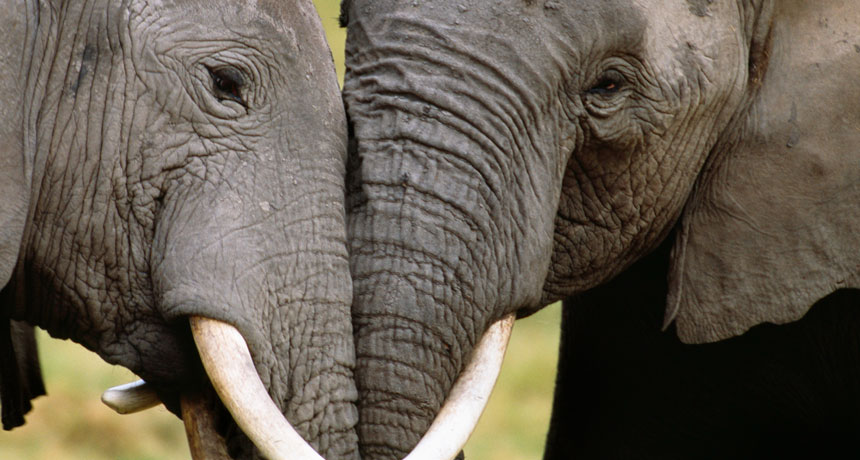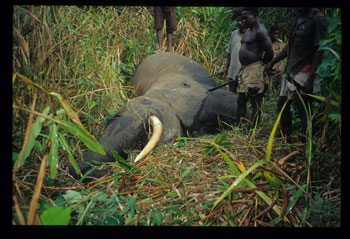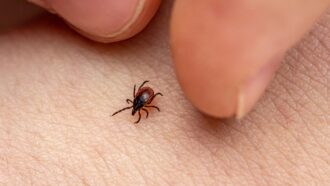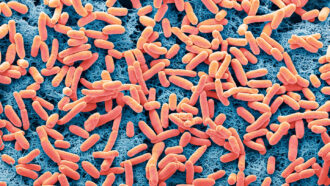DNA in ivory pinpoints elephant poaching hot spots
Study traces illegal trade to two African regions

Tens of thousands of elephants in Africa have been killed for their ivory tusks. A new study uses DNA from those tusks to trace elephant poaching to two main hot spots.
© Art Wolfe/www.artwolfe.com
By Meghan Rosen
Elephants in Africa have been dying by the thousands. Poachers kill the animals for the ivory that makes up their tusks. That ivory is then smuggled around the world. Tracing the origin of the illegal ivory has been hard — until now.
A new study reveals the slaughter of elephants is concentrated in just two regions: central and southeastern Africa. The evidence comes from DNA extracted from the elephants’ tusks. Details appear in a paper published online June 18 in Science.
Other evidence had pointed to these areas before. The new work provides “a smoking gun,” says Fiona Maisels. She is a conservation scientist at the Wildlife Conservation Society in New York City. She was not involved in the new study. Identifying major poaching spots may help officials target the groups killing elephants and smuggling ivory, she says. That could save the lives of elephants across Africa.

In the new study, a group of scientists collected ivory that had been seized in Africa and Asia from 1996 to 2014. The team analyzed half dollar-sized disks carved from the base of each tusk. The tusk contains DNA from the elephant to which it once belonged. For each sample, the researchers generated a pattern of DNA, known as a DNA signature. They then compared this pattern to a map charting the signatures of elephants from across Africa.
With the map, the researchers could trace the origin of each piece of ivory. After 2006, the majority came from just two areas. One was in central Africa. That region overlaps parts of the countries of Gabon, the Democratic Republic of Congo, Cameroon and the Central African Republic. The other was in southeastern Africa. That poaching hot spot straddles Tanzania and Mozambique.
Scientists had previously pegged Tanzania as a hub for poachers, says Samuel Wasser. He is a conservation geneticist at the University of Washington in Seattle. He led the study. “But we didn’t know how extreme it was,” he says. “It’s just mind blowing.”
A recent census of Africa’s elephants showed that Tanzania lost about 12,000 animals just last year. But the country hasn’t owned up to the problem, Wasser says. Tanzanian officials have suggested that maybe the elephants just left the country. The new ivory data say otherwise. Researchers traced thousands of kilograms (pounds) of ivory to Tanzanian elephants. “This kind of evidence is hard to deny,” Wasser says.
The study identified only a small number of poaching hot spots. That suggests only a few large and powerful international groups of criminals are responsible for most of the illegal sales of ivory, Maisels says. Lots of corrupt government officials are probably also involved, she says.
International police plan to use the new DNA evidence to help fight elephant poaching in Africa.
Power Words
(for more about Power Words, click here)
census An official count or survey of a population.
conservation The act of preserving or protecting something. The focus of this work can range from art objects to endangered species and other aspects of the natural environment.
DNA (short for deoxyribonucleic acid) A long, double-stranded and spiral-shaped molecule inside most living cells that carries genetic instructions. In all living things, from plants and animals to microbes, these instructions tell cells which molecules to make.
genetic Having to do with chromosomes, DNA and the genes contained within DNA. The field of science dealing with these biological instructions is known as genetics. People who work in this field are geneticists.
ivory The hard, cream-colored substance that makes up the tusk of an elephant, narwhal or walrus.
poach (in ecology) To illegally hunt and take a wild animal or plant. People who do this are referred to as poachers.
smuggle To move something into or out of a country illegally.







